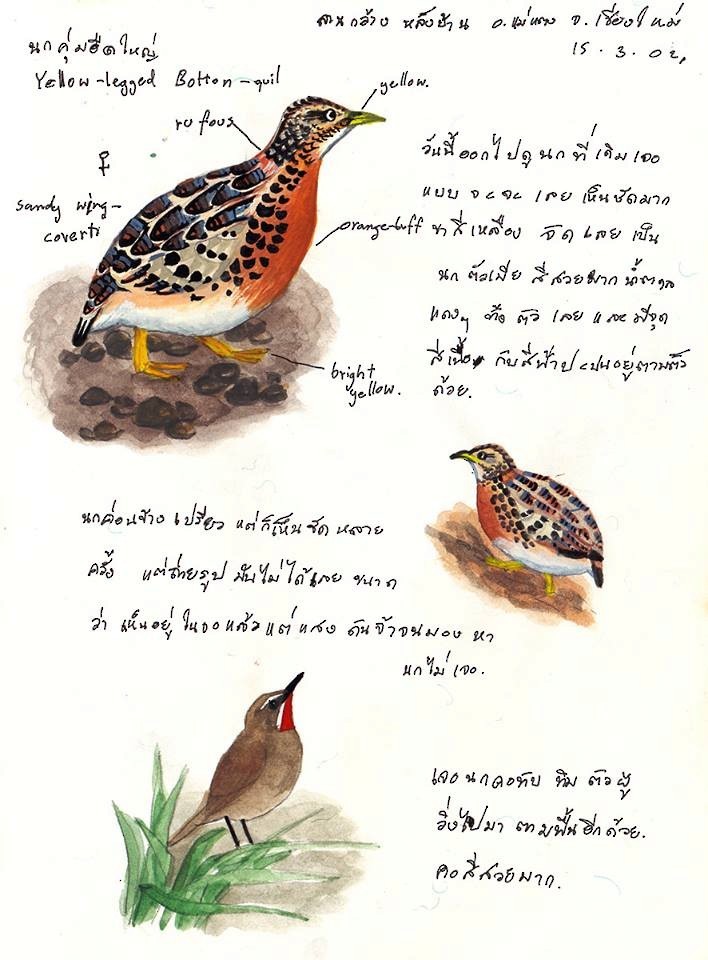Yellow-legged Buttonquail
A species of Buttonquail Scientific name : Turnix tanki Genus : Buttonquail
Yellow-legged Buttonquail, A species of Buttonquail
Botanical name: Turnix tanki
Genus: Buttonquail
Content
Description General Info
 Photo By Ayuwat Jearwattanakanok
Photo By Ayuwat Jearwattanakanok Description
The yellow-legged buttonquail is a small quail growing to a length of 15 to 18 cm (6 to 7 in), the females being slightly larger and more brightly coloured than the males. The weight is 36 to 43 g (1.3 to 1.5 oz) for the subspecies Turnix t. tanki, and 35 to 78 g (1.2 to 2.8 oz) for the male Turnix t. blanfordii, while the female of this subspecies is 93 to 113 g (3.3 to 4.0 oz). The tail is short and the wings have rounded ends. The adult male has a black crown with a buff margin, and sometimes a buff central streak. The front and side of the head are buff, the individual feathers having black tips. The throat is pale buff, darkening to reddish-buff at the edges and on the breast, and paling again on the belly, becoming white at the under tail coverts. The sides of the breast are scattered with round black spots. The nape and upper parts of the body and tail are greyish-brown, with reddish and dark brown vermiculations and spotting. The main wing feathers are blackish-brown with buff margins, and the wing coverts are buff with dark spots. The beak is dull yellow, the irises whitish, and the legs and feet deep yellow. The adult female differs from the male in being a richer colour and in having a broad, reddish-brown collar round the back of the neck. The spots and vermiculations on the back and tail are not so dark, the beak and legs are brighter yellow, and the irises are creamy white or yellowish-brown. In non-breeding plumage, the rufous collar of the female becomes mixed with grey and the other plumage also become greyer. The juvenile is similar to the male in appearance but has dingier plumage, a less vivid breast colour and more fine speckling. 
Size
18 cm
Nest Placement
Ground
Feeding Habits
Yellow-legged Buttonquail consumes grains, seeds, green shoots, and invertebrates including ants, beetles, and grasshoppers, with a preference for seeds. Chicks eat primarily insects but also seeds. Its terrestrial foraging behavior is similar to related species.
Habitat
The habitat of yellow-legged Buttonquail is characterized by a preference for grasslands, including cultivated areas with crops like rice stubble, secondary growth on previously farmed land, and bamboo thickets accompanied by grassy undergrowth. They are also known to inhabit scrubs. Typically, these habitats are found across broad geographical regions with a propensity for areas that are primarily at lower altitudes.
Dite type
Granivorous
General Info
Feeding Habits
Bird food type
Species Status
T. tanki has a very wide range and is a relatively common species. The total number of birds is thought to be stable, and no particular threats to this species have been detected. The International Union for Conservation of Nature has assessed the bird's conservation status as being of "least concern". 

 Photo By Ayuwat Jearwattanakanok
Photo By Ayuwat Jearwattanakanok Scientific Classification
Phylum
Chordates Class
Birds Order
Shorebirds Family
Hemipodes Genus
Buttonquail Species
Yellow-legged Buttonquail